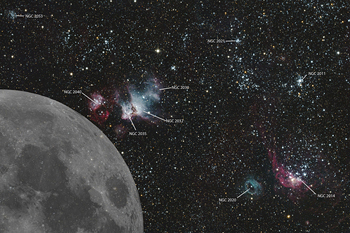 |
CHAMÄLEON + ONJALA OBSERVATORY DeepSky | SITEMAP HOME CHAMÄLEON |
|
 |
|||
| « zurück zur Startseite
galaktische Nebel « back to home galactic nebula |
Großes Bild laden - load large
image 2048 x 1400 Pixel Aufnahmedaten Image data |
NGC 2040, NGC 2032, NGC 2020 and NGC 2014 in the Large Magellanic Cloud

NGC 2040, NGC 2032 und NGC 2014 - Unser Bild zeigt in hoher Auflösung ein besonders interessantes Gebiet von Sternentstehung in der großen Magellanschen Wolke. Die gesamte Region ist als N 59 A nach dem amerikanischen Astronomen Karl Goron Henize katalogisiert. Auffällig sind in diesem Bereich die blauen Reflexionsnebel von NGC 2020 und NGC 2038.
NGC 2040 (N 59 B) ist ein Nebelkomplex, der mit der OB-Assoziation (LH 88) in Verbindung steht und am Rand der Superblase LMC 4 in der etwa 165.000 Lichjahren entfernten Großen Magellanschen Wolke im Sternbild Dorado liegt. Der Komplex besteht aus einem H-II Gebiet im nördlichen Teil und dem Supernovaüberrest SNR 0536?676 im südlichen Teil, der eine fast sphärisch blasenförmige und von Filamenten geprägte Struktur bildet. Sie enthält dutzende massereiche junge Sterne.
NGC 2014, NGC 2020 und NGC 2032
NGC 2014 ist ein offener Sternhaufen, eingebettet in eine H-II Region. Der Sternhaufen ist mit einem wahren Durchmesser von etwa 250 Lichtjahren riesig groß und die H-II Region ist etwa doppelt so groß. Auffällig ist die blaue Farbe von NGC 2020. Normalerweise ist die Strahlung von Emissionsnebeln rötlich, da Wasserstoffgas das häufigste Material in interstellaren Wolken ist und rot leuchtet. NGC 2020 leuchtet jedoch blau, was auf eine ungewöhnlich große Menge an Sauerstoffatomen und die extrem energiereiche Strahlung des heißen, hellen Sterns in der Nähe des Zentrums des Nebels zurückzuführen ist. Gleiches gilt für NGC 2032. Eine Aufnahme des Hubble Weltraumteleskops von NGC 2014 und NGC 2020 zeigen wir hier.
Object description
NGC 2040, NGC 2032 and NGC 2014 - Our high-resolution image shows a particularly interesting region of star formation in the Large Magellanic Cloud. The entire region is cataloged as N 59 A after the American astronomer Karl Goron Henize. The blue reflection nebulae of NGC 2020 and NGC 2038 are striking in this region.
NGC 2040 (N 59 B) is a nebula complex associated with the OB association (LH 88) and located at the edge of the super bubble LMC 4 in the Large Magellanic Cloud in the constellation Dorado, about 165,000 light-years away. The complex consists of an H-II region in the northern part and the supernova remnant SNR 0536-676 in the southern part, which forms an almost spherical bubble-shaped structure characterized by filaments. It contains dozens of massive young stars.
 |
NGC 2014,
NGC 2032 and NGC 2020 -
NGC 2014 is an open star cluster
embedded in an H-II region. The star cluster is huge with a true diameter of
about 250 light-years and the H-II region is about twice as large. The blue
color of NGC 2020 is striking; normally the radiation from emission nebulae is
reddish, as hydrogen gas is the most common material in interstellar clouds and
glows red. However, NGC 2020 glows blue, which is due to an unusually large
amount of oxygen atoms and the extremely energetic radiation from the hot,
bright star near the center of the nebula. The same applies to
NGC 2032, and we show a Hubble Space Telescope
image of NGC 2014 and NGC 2020
here « Klicken Sie hier oder auf das Vorschaubild zum Laden eines großen Bildes mit Objektbezeichnungen. « Click here or on the thumbnail to load a large image with object annotations. |
NGC 2040, NGC 2032, NGC 2020 and NGC 2014 in the Large Magellanic Cloud
Image data
20.05.2023 - 9 x 300 s, QHY ALccd 12 (cooled)
Telescope: PlaneWave CDK 12.5" Astrograph + 0.8x Reducer at f = 2030 mmm
Location: Chamäleon Observatory, Onjala Lodge, Namibia
Image acquisition and processing: DeepSkyStacker, PixInsight + Photoshop
Coordinates: RA: 05 34 00 - DEC: -67 33 30
 |
 |
 |
 |
 |
 |
 |
| Sonne | Mond | Sonnensystem | DeepSky | Weitwinkel | Verschiedenes | Spez. Projekte |